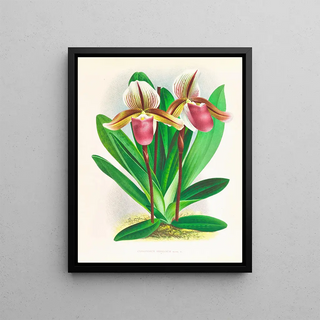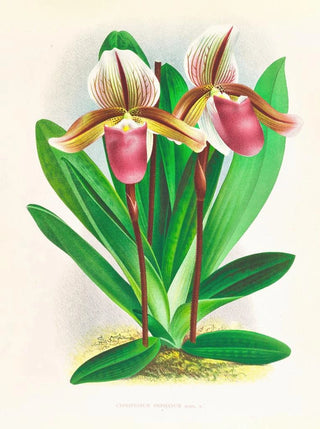Art print | Cypripedium orphanum - Jean Jules Linden


View from behind

Frame (optional)
Cypripedium orphanum Art print - Jean Jules Linden – Captivating introduction
In the vast universe of floral art, the work "Cypripedium orphanum" by Jean Jules Linden stands out for its striking beauty and meticulous attention to detail. This art print, faithful to the original, invites the viewer to immerse themselves in a world where nature and art meet in rare harmony. Through this piece, Linden manages to capture the very essence of the delicacy of orchids, while offering a reflection on the fragility of natural beauty. The viewer is thus transported to a lush garden where each petal seems to vibrate under the rays of the sun, creating an atmosphere that is both serene and enchanting.
Style and uniqueness of the work
Jean Jules Linden's style is characterized by botanical precision that transcends simple floral representation. In "Cypripedium orphanum," every detail is carefully observed, from the subtle nuances of colors to the delicate textures of leaves and flowers. This work is distinguished by its ability to marry realism with an almost poetic approach to nature. The colors, ranging from deep greens to pastel shades, evoke a sense of freshness and vitality. Linden does not merely reproduce the beauty of the orchid; he infuses it with a soul, a life that invites contemplation. The choice of composition, where the orchid stands majestically, draws the eye and gives it a central place, symbolizing rarity and elegance.
The artist and his influence
Jean Jules Linden, a Belgian artist of the 19th century, dedicated his life to the study and representation of plants, particularly orchids. His passion for botany led him to travel around the world, collecting specimens and drawing inspiration from the floral diversity he encountered. Linden is recognized not only for his artistic talent but also for his pioneering role in the field of botanical illustration. His works contributed to a better understanding and appreciation of exotic plants, influencing many artists and botanists of his time. His approach, combining science and art, paved the way for a new way of seeing nature, where each flower becomes a subject worthy of celebration.

Matte finish

View from behind

Frame (optional)
Cypripedium orphanum Art print - Jean Jules Linden – Captivating introduction
In the vast universe of floral art, the work "Cypripedium orphanum" by Jean Jules Linden stands out for its striking beauty and meticulous attention to detail. This art print, faithful to the original, invites the viewer to immerse themselves in a world where nature and art meet in rare harmony. Through this piece, Linden manages to capture the very essence of the delicacy of orchids, while offering a reflection on the fragility of natural beauty. The viewer is thus transported to a lush garden where each petal seems to vibrate under the rays of the sun, creating an atmosphere that is both serene and enchanting.
Style and uniqueness of the work
Jean Jules Linden's style is characterized by botanical precision that transcends simple floral representation. In "Cypripedium orphanum," every detail is carefully observed, from the subtle nuances of colors to the delicate textures of leaves and flowers. This work is distinguished by its ability to marry realism with an almost poetic approach to nature. The colors, ranging from deep greens to pastel shades, evoke a sense of freshness and vitality. Linden does not merely reproduce the beauty of the orchid; he infuses it with a soul, a life that invites contemplation. The choice of composition, where the orchid stands majestically, draws the eye and gives it a central place, symbolizing rarity and elegance.
The artist and his influence
Jean Jules Linden, a Belgian artist of the 19th century, dedicated his life to the study and representation of plants, particularly orchids. His passion for botany led him to travel around the world, collecting specimens and drawing inspiration from the floral diversity he encountered. Linden is recognized not only for his artistic talent but also for his pioneering role in the field of botanical illustration. His works contributed to a better understanding and appreciation of exotic plants, influencing many artists and botanists of his time. His approach, combining science and art, paved the way for a new way of seeing nature, where each flower becomes a subject worthy of celebration.






